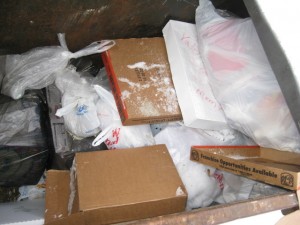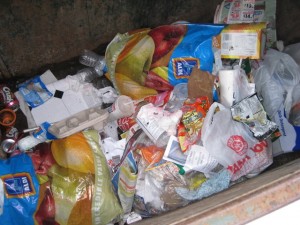Annie Leonard is the author of The Story of Stuff: How Our Obsession with Stuff Is Trashing the Planet, Our Communities, and Our Health-and a Vision for Change. I am only partially through her excellent book at this time. Tonight, however, I clicked over to her site to see what Annie had to say in her 20 minute video, “”The Story of Stuff.” It turns out that upbeat Annie, surrounded by cartoonish images, will fill your head with dozens of depressing statistics that will inexorably lead you to the conclusion that we’ve got to change our ways.

Annie starts out with a warning that we have a “system in crisis.” We have is a “linear” system on a “finite planet.” We also have a big problem getting our government to pay attention. More than 50% of our tax money goes to the military, and our corporations seem to own our government (51 of the largest economies in the world are corporations). Consider also Annie’s well honed argument that our official government policy is that we should purchase lots of unnecessary stuff and trash the planet.
Many other sites that can give you comparable statistics, but few of them have worked n my conscience as much as Annie Leonard’s site. The United States has 5% of the world’s population, but uses 30% of the worlds resources. If everyone lived like people in the United States, we would need 3 to 5 planets. Every minute, seven football fields worth of trees (about 2000 trees) are cut down in the Amazon. There are 100,000 chemicals commonly used in our products, and very few of them have ever been tested for human safety . Annie points out that almost none of of these chemicals ave been tested for “synergistic effects (to see how safe they are when used in combination with other chemicals). BFR’s (used for fire retardation) are commonly used in computers, couches and the pillows on which you rest your head on each night. The food with one of the highest concentrations of toxins is human breast milk.
Who pays for all the heap electronic gadgets that we use? Annie argues that we are all paying for them with the loss of resources and the loss of clean air. The price for these cheap electronics are mostly off the books. We also pay for this cheap stuff by filling our country with trash.

Only 1% of the products that flow through the manufacturing system are still in use six months later. In other words, 99% of the stuff we produce becomes trash within six months. I found myself thinking about this issue a few months ago when I went dumpster diving with my daughters; we spotted many dumpsters that were filled mostly with packing materials and pizza boxes. Annie argues that the average American produces 4 1/2 pounds of trash per day, which is twice the rate the average American produced 30 years ago.
We can look at this in at least two ways. Perhaps this kind of information depresses you. On the other hand, we can realize hat there are many ways that we can improve the system such that we become focused on sustainability and equity instead of excelling at making trash. As Annie states toward the end of her video, one of the most important things we need to do is to take back our government so that we can start doing the right things on a much bigger scale.
If you think this is unrealistic to change the way things are going, there’s another reason to be more or less hopeful. It’s that we’re running out of resources and we’re running out of places to put our trash. In other words, we will need to change because the status quo itself is unsustainable.


Annie Leonard is a great teacher, she simplifies important facts for anyone.
It seems like 20 years ago, when I was in high school, everyone was talking about the landfills as an environmental problem. I don’t hear that so much anymore, is that b/c the world is so much more screwed now?
Annie Leonard is a great teacher, she simplifies important facts for anyone.
It seems like 20 years ago, when I was in high school, everyone was talking about the landfills as an environmental problem. I don't hear that so much anymore, is that b/c the world is so much more screwed now?
Erich:
The scale of the challenges that face us is daunting, but the sheer wastefulness of the average American means that we can make an enormous impact without much suffering or privation. For example, if the average American were able to reduce their energy usage to be on par with the average European, the US could become energy independent– and even have some energy left over for export. In real terms though, this means a reduction of 2/3 of our current energy usage.
The real point, which you make in your last paragraph, is that we are going to make these changes anyway. Either we choose (soon!) to implement voluntary conservation and energy reduction programs, or the skyrocketing prices and cascading system shocks will do it for us.
One of the biggest challenges facing the US in energy terms is urban sprawl. Europe is exceedingly compact, and compact means a lot less energy wasted on distribution, transportation, and recovery.
I live in a very nice suburban neighborhood (complete with golf course). It’s a mile from my home (by road) to the closest neighborhood entrance. It’s another mile (more or less) to the closest supermarket(+ strip mall) and gas station. The distance from my home to the supermarket – as the crow flies) is less than 1/4 mile – but you’d need wire cutters, ladders, and heavy-duty pruning shears to go direct.
There is no public transportation (no bus stop) closer than 4 miles (by road)
This means that we NEED two cars, since my wife and I are often doing different things for work, school, and leisure that require transportation. (I’d bike, but it’s hard to car-pool kids to/from band/soccer/etc on a bicycle)
Most of the neighborhoods in this area (north of Atlanta) are very similar – and in my travels around the country for business, I see this pattern replicated again and again.
Against this sprawl, the individual changes people can make pale into insignificance. Infrastructure is expensive to install, and changing infrastructure is even more expensive.
Zoning has much to do with this – but citizens are ultimately responsible for requiring zoning that kept smelly industry away from neighborhoods – it’s citizens who voted for the planners.
Brynn: I hope to have a followup post tonight based on a new article in Science, showing that substantial conservation is the bridge that can lead us to the other side (to sustainable energy). It is, in fact, the only hope.
Most of the “facts” in this film are blatantly false. So much in fact that it’s the topic of my environmental science course as an example of misleading and unscientific propaganda. The statistic about 4% of forests is one of the most egregious lies in this film.
Ken: When a reader argues that someone else has “lied,” I expect (and the rest of us deserve) a link to a reputable authority. What is your information regarding “4% of forests.” I ask this, because in my experience, Annie Leonard has documented her information carefully.
I echo Erich’s expectation. Ken should produce the source(s) that contradict the video and let DI readers decide. One can’t engage in a serious debate when one side makes unsupported claims.
Cada um é livre de emitir as suas opiniões mas atenção O PLANETA É DE TODOS e todos (excepto os que são insensiveis) devemos OBRIGATÓRIAMENTE pugnar pela sua perservação reduzindo o CONSUMISMO ANARQUICO que alguns praticam. O resto é conversa fiada….